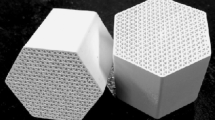Abstract
The rheological properties of molding systems are shown to depend on the spreadability of the mixture under the action of its own mass; some of the factors influencing the self-flow are determined, namely, the moisture content, the content of the filler, and the temperature of the mixture. The described self-flow castables based on a mullite HCBS and a SiC filler have a porosity of 18% after drying and 16 – 16.5% after heat treatment. Their ultimate bending strength is 45 MPa and the ultimate compressive strength is 110 MPa, which is higher than those of the known refractories of similar compositions. The temperature of 4% deformation of mullite – silicon carbide refractory heat treated at 1350°C and having C Vf = 0.4 is 1710 – 1720°C, which is 70 – 80°C higher than that of a similar material molded by pressing and heat treated at 1500°C.
Similar content being viewed by others
REFERENCES
Yu. E. Pivinskii and M. A. Skuratov, “Cast (self-flow) ceramic castables. 3. Rheotechnological properties of molding mixtures for fabricating silicon carbide ceramic castables,” Ogneup. Tekh. Keram., No. 11, 32-36 (2000).
Yu. E. Pivinskii, “Fundamentals of the technology of ceramic castables,” Ogneupory, No. 2, 34-42 (1978).
Yu. M. Bazhenov, The Technology of Concretes [in Russian], Vysshaya Shkola, Moscow (1978).
Yu. E. Pivinskii, “Ceramic castables: concluding stage in the evolution of low-cement refractory concretes (Part I),” Ogneup. Tekh. Keram., No. 1, 11-15 (2000).
Yu. E. Pivinskii and K. V. Timoshenko, “Cast (self-flow) ceramic castables. 1. Fabrication and some properties of cast silicon carbide ceramic castables,” Ogneup. Tekh. Keram., No. 10, 16-22 (1999).
Yu. E. Pivinskii and K. V. Timoshenko, “Cast (self-flow) ceramic castables. 2. Effect of structure-forming additives in high-alumina cement on the properties of ceramic castables,” Ogneup. Tekh. Keram., No. 7, 17-20 (1999).
I. S. Kainarskii and É. V. Degtyareva, Carborundum Refractories [in Russian], Metallurgiya, Kharkov (1963).
R. Ya. Popil'skii and Yu. E. Pivinskii, Pressing of Powder Ceramic Mixtures [in Russian], Metallurgiya, Moscow (1983).
B. V. Gusev and V. G. Zazimkov, Vibration Technology of Concrete [in Russian], Budivel'nik, Kiev (1991).
Yu. E. Pivinskii, “A study of vibration molding of ceramic castables. Molding systems and basic laws,” Ogneupory, No. 6, 8-14 (1993).
Yu. E. Pivinskii, Ceramic Binders and Ceramic Castables [in Russian], Metallurgiya, Moscow (1990).
Yu. E. Pivinskii, “Highly concentrated ceramic binding suspensions, methods, and principles of the technology,” Ogneupory, No. 9, 18-24 (1987).
Yu. E. Pivinskii and A. G. Romashin, Quartz Ceramics [in Russian], Metallurgiya, Moscow (1974).
Yu. E. Pivinskii and N. N. Kruglitskii, “On the effect of temperature on the rheological behavior of Newtonian disperse systems,” Kolloid. Zh., 996-999 (1975).
I. S. Kainarskii and É. V. Degtyareva, in: Coll. Works of UNIIO, Issue 4 (LI) [in Russian], Metallurgizdat, Moscow (1960), p. 5.
Author information
Authors and Affiliations
Rights and permissions
About this article
Cite this article
Skuratov, M.A., Pivinskii, Y.E. Cast (Self-Flow) Ceramic Castables. 4. Spreadability of Molding Systems and Some Properties of Mullite – Silicon Carbide Ceramic Castables. Refractories and Industrial Ceramics 42, 23–29 (2001). https://doi.org/10.1023/A:1011388817677
Issue Date:
DOI: https://doi.org/10.1023/A:1011388817677



